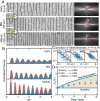The mesoscale order of nacreous pearls
- PMID: 34663700
- PMCID: PMC8545470
- DOI: 10.1073/pnas.2107477118
The mesoscale order of nacreous pearls
Abstract
A pearl's distinguished beauty and toughness are attributable to the periodic stacking of aragonite tablets known as nacre. Nacre has naturally occurring mesoscale periodicity that remarkably arises in the absence of discrete translational symmetry. Gleaning the inspiring biomineral design of a pearl requires quantifying its structural coherence and understanding the stochastic processes that influence formation. By characterizing the entire structure of pearls (∼3 mm) in a cross-section at high resolution, we show that nacre has medium-range mesoscale periodicity. Self-correcting growth mechanisms actively remedy disorder and topological defects of the tablets and act as a countervailing process to long-range disorder. Nacre has a correlation length of roughly 16 tablets (∼5.5 µm) despite persistent fluctuations and topological defects. For longer distances (>25 tablets , ∼8.5 µm), the frequency spectrum of nacre tablets follows [Formula: see text] behavior, suggesting that growth is coupled to external stochastic processes-a universality found across disparate natural phenomena, which now includes pearls.
Keywords: SEM; TEM; mesoscale; nacre; pearls.
Copyright © 2021 the Author(s). Published by PNAS.
Conflict of interest statement
The authors declare no competing interest.
Figures




References
-
- Blake J. M., The Castle (José Cornejo Franco Library, Guadalajara, Mexico, 2007).
-
- Bellini T., Radzihovsky L., Toner J., Clark N. A., Universality and scaling in the disordering of a smectic liquid crystal. Science 294, 1074–1079 (2001). - PubMed
-
- Keen D. A., Goodwin A. L., The crystallography of correlated disorder. Nature 521, 303–309 (2015). - PubMed
-
- Hosemann R., Vogel W., Weick D., Baltá-Calleja F. J., Novel aspects of the real paracrystal. Acta Crystallogr. A 37, 85–91 (1981).
-
- Wilson J. S., Stability of structures. Nature 136, 568–571 (1935).
Publication types
LinkOut - more resources
Full Text Sources

